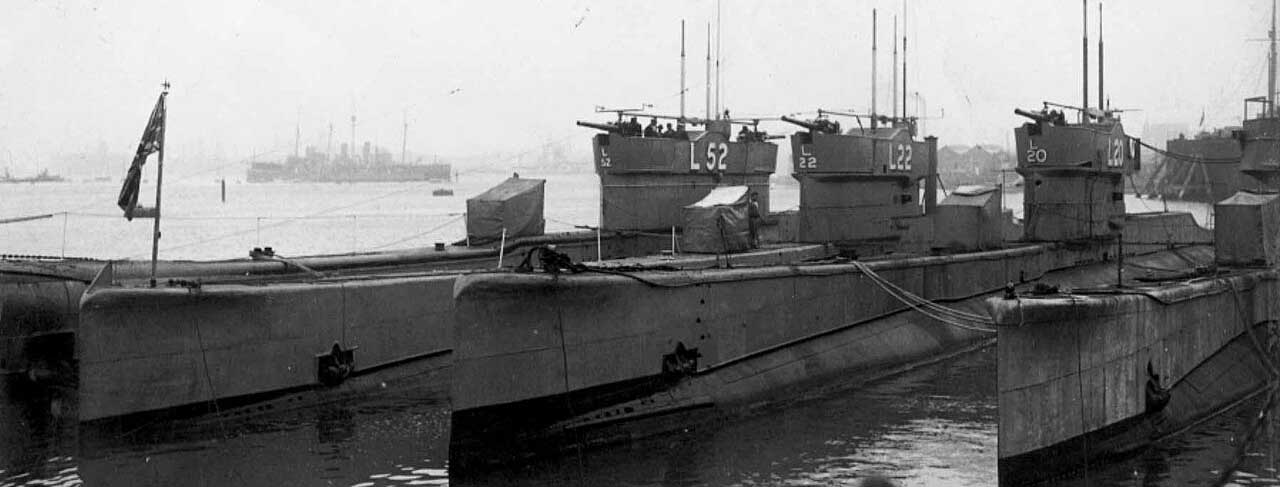
 Patrol Submersibles 1917-45:
Patrol Submersibles 1917-45:
32 over the L1, L9 and L50 classes, 30+ cancelled 1918
WW1 British Submersibles:
Nordenfelt Class | Holland Class | A class | B class | C class | D class | E class | F class | G class | G class | H class | J class | K class | HMS Swordfish | HMS Nautilus | L Class | M class | R class | S classV class | W classThe L class submersibles were the last built for the RN during the great war, and some saw even action in WW2 as training boats. They were the last of the long line going back to the Holland boats of 1901, and arguably fixed many trademarks still present in interwar British submersibles. Launched from 1917 in three successive classes (L1, L9 and L50) most of the latter were cancelled, and they saw little service in WWI, going for man more years of interwar service and helping, replacing all previous generations. #royalnavy #submersibles #submarines #britishnavy #lclass
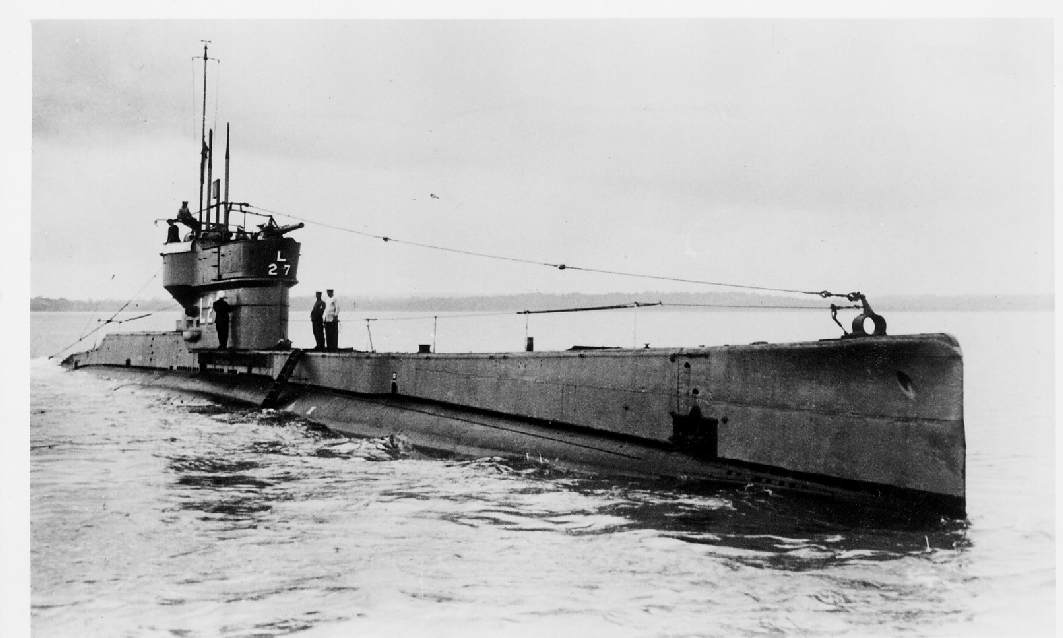
L27, group II boat
Design of the class
Development and order

The previous E class plan src
The British L-class submarine was originally planned as part of the emergency war programme as an improved version of the successful British E-class, but with so many changes in all areas, that it became its own sub-class and later declined into two more of its own sub-classes, called group 2 and group 3 as the design evolved between 116 and 1919. A grand total of 74 were ordered, of which 31 were effectively completed.
Changes included the major innovation of having 21-inch (533 mm) torpedo tubes on Group 2-3, which packed far more punch than the usual 18 inches (450 mm). Group 3 boats had one more gun, for two QF 4-inch fore and aft and a lengthened conning tower allowing to have both protected by open turrets. The L class also innovated as having, for the first time, external hull wing tanks, rated for 76 tons of fuel oil. Group 1 boats were tailored for minelaying operation as well, and in Group 2 boats, four were also modified to be used as minelayers, with 16 mines and missing their beam torpedo tubes.
Hull and general design
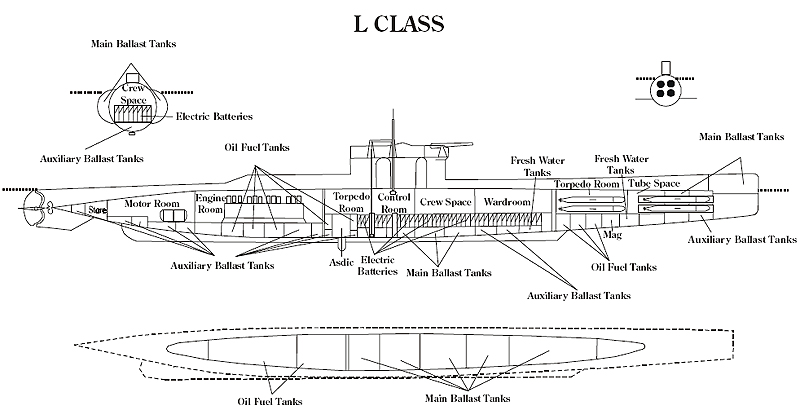
Internal layout summary brief – scr
They were essentially a repeat of the E-class, albeit a bit larger. Straight prow, roughly 1/10 ratio, narrow deck ending way short of the stern external hull, ballasts, larger conning tower located forward amidships, two pairs of diving pairs forward and aft. The Group I boats were very much a repeat of the E class, with a same small conning towrer and deck gun, the only difference was its location on a raised part of the deck.
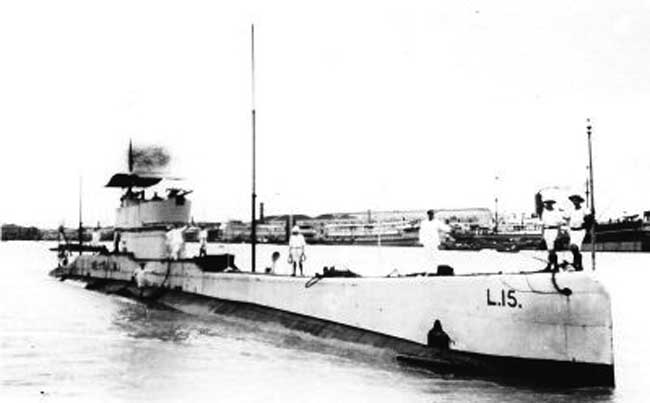
L15 at the China Station
The biggest change by far on group II was the location of the main gun, fruit of wartime lessons. Since surface navigation was the norm and deck gunnery a relatively frequent occurrence, it was recognised that sitting that low over the water (even on a raised deck) in heavy weather, water spray was making its use quite difficult. It was decided that relocating the gun on a conning tower platform with bulwarks would solve the issue, better protect gunners and give them a better field of view. The had the longest, largest “sail” ever seen on a British submarine, and it became a trademark for the future. However no boat in this new configuration was ready when WWI ended.
The crew comprised 4 Officers and 37 men, sharing the relatively narrow tube, single stage, of the pressure hull. The conning tower comprised two 30 foot periscopes and they were in 1920 equipped with a Type 113 asdic set, the first model ever installed on British submarines (see later).
Powerplant & performances
The powerplant saw no major revolution, it was in a straight line derived from the L class, with two Diesel engines rated for 2,400 HP and 17.5 knots surfaced, max. They carried in two external saddle tanks 76 tons oil fuel for a range of 2,380 miles at 16 knots, so near full speed, or 4030 miles at 8 knots for usual patrols. In general, at this rate, they burned 1.7 tons per day.
The Main electric motors developed 1600 HP for a total of 10 ½ knots submerged and batteries comprised 336 cells, enough to give the L class an autonomy submerged or one hour and a half at 9 knots.
The hull was designed with saddle Tank type for an operational diving depth of 150 feet (45 meters).
Armament
Artillery
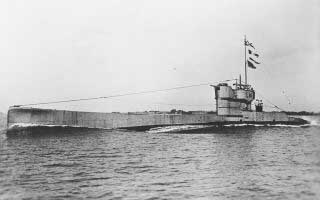 That was a complicated topic with many changes. Initial plans for L1 was on plan to incorporate a 3-in H.A. 20 cwt gun on a disappearing mounting, but as built it could be different.
That was a complicated topic with many changes. Initial plans for L1 was on plan to incorporate a 3-in H.A. 20 cwt gun on a disappearing mounting, but as built it could be different.
L2 and the following Group I serie indeed had various configurations, with the norm being seemingly a 3-in in fixed positions forward or a 4-in Q.F., or both, on deck fore and aft. In 1919 they were all standardized with a single 4-in gun on deck.
As for Group II, L 9 Group, they had a 4-in gun on foredeck or bridge from L 12 onward, with a source indicating L 9 also had a bridge 4-in.
Group II were all completed woth a double ended conning tower/bridge and 4-in guns of the same models fore and aft.
The 4-in guns (101.6 mm) were either Mk XII or later XXII (boats completed 1923-24).
They weighted 2,750 pounds (1,250 kg) barrel & breech for 160 inches (4.064 m) bore (40 calibres) in lenght, firing a Fixed QF 31 pounds (14.06 kg) shell at up to +20°, 1,873 feet per second (571 m/s) and c8,000 yards at +20°. It was successful and still used in WW2.
Torpedoes
18-inch (450 mm): Likely Mark VIII (1913), carrying a 320 lb (150 kg) TNT warhead, powered by Wet heater and capable of 35 knots (65 km/h; 40 mph) for 2,500 yd (2,300 m).
21-inches (533 mm): Likely Mark II, Mark II (1914), carrying a 400-515 lb (181 to 234 kg) TNT warhead, powered by Wet Heate to 8,000 yd (7,300 m) at 29 to 35 kn (54 to 65 km/h).
Type 113 Asdic
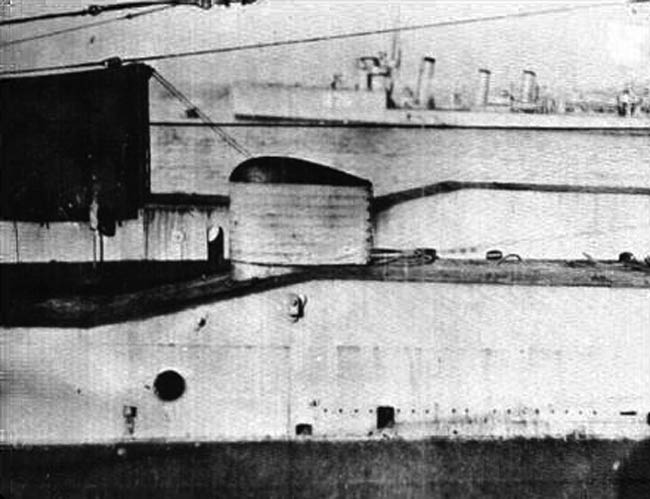
A postwar addition, these were only fitted to Group III L Class submarines in 1925. By 1926 seven had it, positioned aft of the fin for all-round reception. The sound reflector arrangement programme was abandoned, the Type 113 was kept on the boats assigned to the 5th Training Flotilla until 1937, considered obsolete. It was initially designed to use in the active mode for determining the range of a target but it was found to act as an excellent hydrophone, and so mostly used in passive mode.
Radios
In 1918, “E” class boats received a 3 kilowatt Poulsen wireless set with 200 miles submarine-to-submarine range or 300-400 miles with shore stations. They were also adopted for the next L class and upgraded in the interwar.

Former Atlas publications profile of a group III, accuracy to take with a grain of salt.
⚙ L-class Group I specs |
|
| Displacement | |
| Dimensions | 222 ft (67.7 m) x 23 ft 6 in (7.16 m) |
| Propulsion | |
| Speed | 17.3 knots (32.0 km/h; 19.9 mph) surfaced/10.5 knots underwater |
| Range | 2,800 nmi (5,200 km) at 10 kn (19 km/h; 12 mph) surfaced |
| Armament | 6× 18-in (450 mm) TTs (4 bow, 2 beam, 10), one 4-inch gun |
| Crew | 35 |
Group II Boats
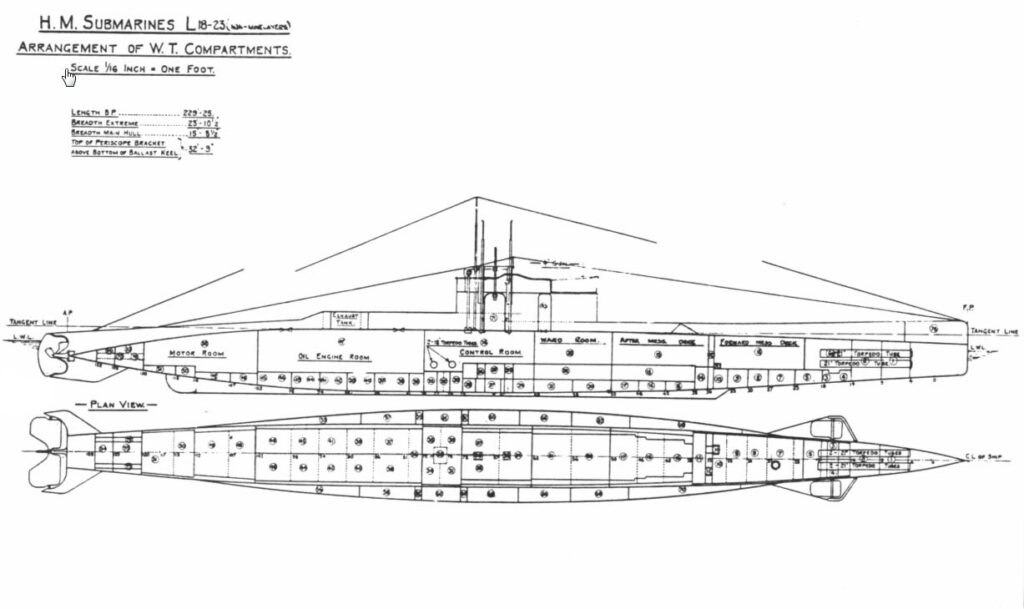
L23 plan, group 2 boat. src northeastatwar.co.uk
Boats constructed, by yard:
Denny — L 9 (29.1.18, sold for BU 6.27), L 10 (24.1.18, sunk by destroyer 30.10.18)
Fairfield —L 15 (16.1.18, sold for BU 2.32), L 16 (9.4.18, sold for BU 2.34) Vickers —L 18 (21.11.18, sold for BU 10.36), L 19 (4.2.19, sold for BU 1937), L 20 (23.9.18. sold for BU 1.35), L 21 (11.10.19, sold for BU 2.39), L 22 (25.10.19, sold for BU 8.35), L 23 (1.7.19, sold for BU 1946), L 24 (19.2.19, sunk in collision 14.1.24), L 26 (29.5.19, sold for BU 1946), L 27 (14.6.19, sold for BU 1946), L 28 (-, cancelled 1919), L 29 (-, cancelled 1919), L 30 (-, cancelled 1919), L 31 (-, cancelled 1919), L 32 (23.8.19, cancelled 1919, sold for BU 3.20)
Swant Hunter — L 33 (29.5.19, sold 1932)
Pembroke DYd — L 34 (~, cancelled 1919), L 35 (-, cancelled 1919)
Orders not placed: —L 36-L 49
Minelayers (all Vickers-built) — L 1 (26.2.18, sold for BU 2.32), L 12 (16.3.18, sold for BU 2.32), L 14 (10.6.18, sold for BU 5.34), L 17 (13.5.18, sold for BU 2.34), L 25 13.2.19, sold for BU 1935).
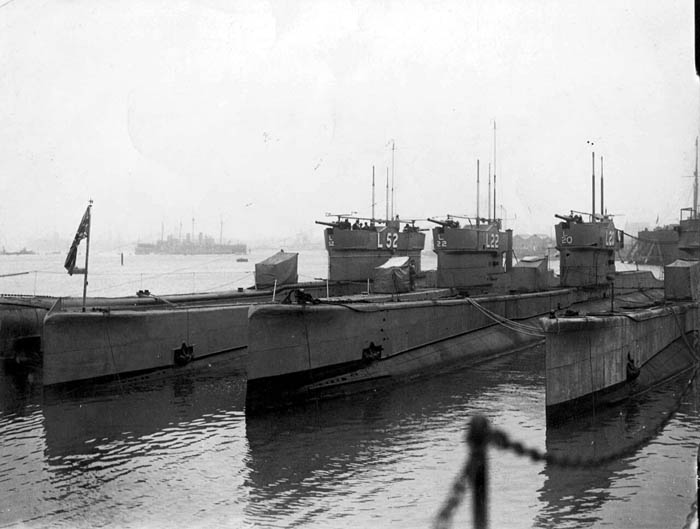
L class boats, Group II at Gosport in 1933
War experience demanded a heavier bow salvo, and so the second batch of “L” class was given 4—21 in TTs, although the beam 18-in were retained to avoid having to enlarge the hull. The lead boat L 9 was ordered in August 1916, followed by L/0-L 35 in December (excluding the ‘unlucky’ L 73). Although it was planned to build L 36-L 49 later, orders were not placed. Five boats were completed as minelayers, along the lines of the ‘E’ class, with vertical mine-chutes in the saddle tanks. L 11, L 12, L 14 and L 17 had 16 mine-tubes (16 mines) but L 25 had only 14 tubes. From L 12 onwards the 4in gun was raised to the bridge deck level, where it was served by an enclosed access trunk.
This arrangement was intended to permit the ‘L’s to engage a U-boat out of torpedo-range, with the boat trimmed down. They were a great improvement over the ‘E’ class, particularly in accommodation. Three survived to the end of the Second World War on training duties. Seven were cancelled in 1918-19.
The main alterations were dictated by the change to 21 in TT. The pressure hull was lengthened by 7ft 6in and a water-tight bulkhead was added abaft the bow TT to separate the tube compartment from the forward torpedo room. From L 18 onwards 78t more fuel was carried, an improvement which was retro-fitted to the earlier ‘L’ class and L 9—L 17. No spare torpedoes were carried for the beam TT.
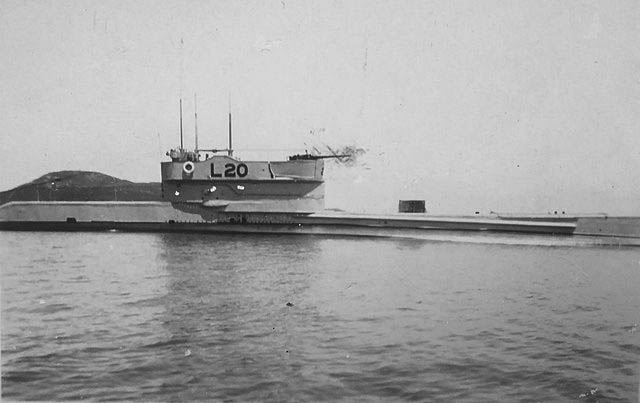
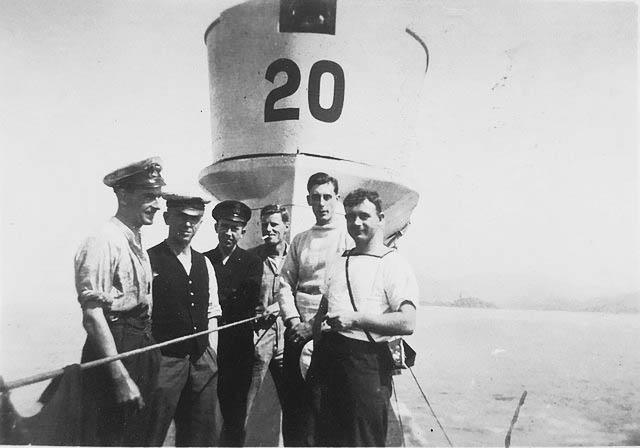
The CT of HMS L 20 and crew on the Yang Tse, 1929, Thomas C. Wilding collection.
Group II confirmed the Admiralty’s return to the saddle-tank type submarine and the evolution was an Admiralty design, this time armed with four 21 inch bow tubes, two 18 inch beam tubes and configuration as minelayers still with four 21 inch bow tubes (the beam tibes were reworked to hold and release mines).
They had a gun forward of the conning tower but if Group I had 3 inch high-angle anti-aircraft gun, the standard became a 4 inch dual purpose gun.
Changes as as followed below:
⚙ L-class Group II specs |
|
| Displacement | 914 long tons (929 t) surfaced, 1,089 long tons (1,106 t) submerged |
| Dimensions | 228 ft (69.5 m), same |
| Propulsion | Same as Group I |
| Speed | 17 knots (31 km/h; 20 mph), same |
| Range | Same as Group I |
| Armament | 4× 21-in (533 mm) bow TTs, 2× 18-in (450 mm) beam TTs (8+2), 1× 4-in gun or 16 mines |
| Crew | 38 |
Group III Boats
Group III really solidified, in parallel to the “fleet boats” of J class, group II, all the peculiarities of interwar British submarines; They were the bedrock on which was created the next O class (Odin).
Boats constructed, by yard:
L 50 (Cammell Laird, cancelled 1919), L 51 (Cammell Laird, cancelled 1919), L 52 (Armstrong, launched 18.12.18 1919 sold for BU 1935), L 53 (Armstrong, launched 12.08.19 sold for BU 1938), L 54 (Denny, launched 20.08.19 sold for BU 1938), L 55 (Fairfield, launched 21.09.18 sunk 09.06.1919), L 56 (Fairfield, launched 25.05.19 sold for BU 1938), L 57 (Fairfield, cancelled 1919), L 58 (Fairfield, cancelled 1918), L 59 (Beardmore, cancelled 1918), L 60 (Cammell Laird, cancelled 1918), L 61 (Cammell Laird, cancelled 1918), L 61 (same, cancelled 1918), L 62 (Fairfield, cancelled 1918), L 63 (Scott, cancelled 1918), L 64 (Scott, cancelled 1918), L 65 (Swan Hunter, cancelled 1918), L 66 (Swan Hunter, cancelled 1918), L 67 (Armstrong, cancelled 1918), L 68 (Armstrong, cancelled 1919), L 69 (Beardmore, launched 6.12.18, sold for BU 2.39), L 70 (Beardmore, cancelled 1919). L 71 (Scott, launched 17.5.19, sold for BU 3.38), L 72 (Scott, cancelled 1919), L 73 (Denny, cancelled 1919), L 74 (Denny, cancelled 1918).
An expansion of the “L” design was authorised early in 1917, before any experience had been gained with L 1—L 8 (Group I), but as that class was successful the Machinery: As “L” class except range 4500nm at 8kts surfaced. The L 5O design simply wad provided heavier armament. L 50-L 55 were ordered in January-February 1917, followed by L 56-L 58 in April 1917 and L 59-L 66 and L 74 in April 1918, but most were in an early stage of building by the Armistice. L 59-L 66 and L 74 were cancelled by Admiralty Order of 26 November 1918, followed by L 50, L 51, L 57, L 58, L 67, L 68, L 70, L 72 Class and L 73 in April 1919.
The frames for L 67 and L 68 were used to build the Yugoslav Hrabri and Nebojsa in 1927. L 53 was towed to Chatham DYd for completion in January 1925, L 54 to Devonport DYd for completion on 5 August 1924, and L 69 to Devonport for completion in April 1923. They were easily distinguished from the earlier “L” class by having a second 4in gun platform at the after end of the conning tower. The bow salvo was increased to six 21-in TT and the beam tubes were omitted. L 55 completed in December 1918 and was sent to the Baltic early 1919, sunk off Kronstadt in 1919 by Russian patrol craft, she was later raised, repaired and incorporated into Soviet Navy under the same number.
So the conning tower was enlarged to that two 4-in (102 mm) general purpose guns could be mounted on it, and cleaned the deck free or obstruction. The latter was raised amidship, close to the CT. Apart this, the other great chgange was the all 21-in tubes for torpedoes, all in the bow. They were the firdt British submarines with six bow tubes. They also carried 12 “spare” torpedoes one already pre-loaded in each tube before departing in patrol to not waste space. Unlike Group II boats they never were midfied as minelayers. None entered servce before the war ended and the immense majority of the L-50 to L-73 (23 boats) were cancelled in November 1918.
⚙ L-class Group III specs |
|
| Displacement | 960 long tons (975 t) surfaced, 1,150 long tons (1,168 t) submerged |
| Dimensions | 230 ft 6 in (70.3 m), same |
| Propulsion | Same as Group I |
| Speed | 17.5 knots (32.4 km/h; 20.1 mph), same |
| Range | 4,800 nmi (8,900 km) at 8 kn (15 km/h; 9.2 mph) surfaced |
| Armament | 6× 21-in (533 mm) bow TTs (12), 2× 4-in (102 mm) guns |
| Crew | 44 |
The L class in action
The L class arrived too late to make an impression in World War I. Apart the ongoing rampage of German U-Boats in the Atlantic, the naval war was practically over since Jutland. So these subs spent their few months of service i=n convoy escort and training. L2 was accidentally depth-charged by three American destroyers at this occasion, by early 1918. L12 was the only successful “hunter killer” of the class, managing to torpedo the German submarine UB-90. L10 sank the German destroyer S33 in October 1918 until being chased down and sank herself. L24 collied with the battleship HMS Resolution during an exercise off Portland Bill (English Channel) on 10 January 1924.
The “L” class overall formed the backbone of British submarine flotillas in the twenties, between Home waters, Mediterranean, Indian Ocean and the China Station. The first L class arrived there by 1919, and up to 12 were posted, creating a local deterrence. By 1929 most of the completed boats, 30 remained in service, with ten placed in reseverve, and in 1939 only three saw service still, active until 1940 and then versed in training purposes for the new generation of the S-class crews. In 1944 all three were sent to the RCAN as “targets” to train ASW convoy escort vessels crews.
Here are the career of some of the most remarkable boats in this class to see action.
 HMS L1 (1917)
HMS L1 (1917)
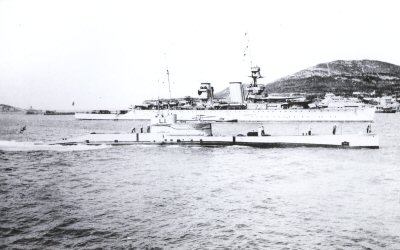
HMS L1 post-refit, postwar. Note the 4-in gun relocated on CT.
Originally laid down by Vickers, Barrow, as the E-class E57 on 18 May 1916, and with E58 incorporated enough changes to be designated in the new L class. L1 was launched 10 May 1917, commissioned on 10 November 1917 and sailed with the Depot Ship HMS Ambrose (1903) to Hong Kong in 1919, 4th Submarine Flotilla, then reserve flotilla 1923 (Hong Kong) until sold March 1930 for scrap but under tow to Newport, broke free, stranded at Penanwell Cove (Cornwall) scrapped on site.
 HMS L2 (1917)
HMS L2 (1917)
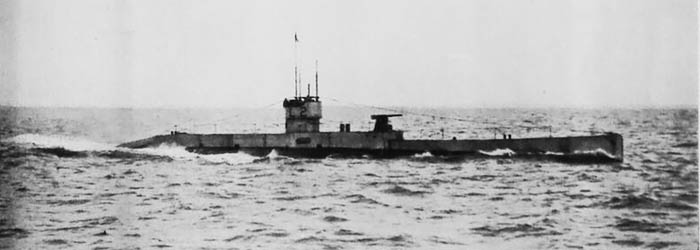
L2 in her original appearance, very much a E-class boat.
Same story as her sister L1, she ws originaly E 58, then reclassed as L class boat, was launched on 6 July 1917, commissioned on 18 December 1917. Like her sister she saw action in WWI. On 24 February 1918, she was mistook by an U-Boat and fired upon by the destroyers USS Davis, USS Paulding, and USS Trippe while on their scouting line in the Atlantic, south coast of Ireland and underway to Queenstown. USS Paulding L2’s periscope first header for her at flank speed opening gunfire. L2 commander rightly assumed seeing the destroyers behaviour she was a target and submerged to 90 feet (27 m) and the, hearing about the splashed, to 200 feet (61 m). Paulding dropped two depth charges and L2 severely had her diving planes jammed in hard-upward position so she took an until her stern struck the seabed at 300 feet (91 m) while four more depth charges exploded around. Lt. Cdr Anworth gave the order to blow N°5-6 ballast tanks so she could surface, bow-first. USS Davis dropped a depth charge very close then all three destroyers opened gunfire pount blank (1,500 yards/1,370 m), and performed L 2 pressure hull abaft the conning tower. Some of crew emerged from the conning tower waving a White Ensign, launching a smoke grenade and the DDs ceased fire. L 2 was escorted to Berehaven, Ireland for initial repairs. The irony was both the The force commander of British submarines, Captain Martin Dunbar-Nasmith, commended both L2 and the US destroyers while reporting the incident. Admiral Lewis Bayly even wrote “…The U. S. destroyers deserve great credit for their smartness in attack, and for their quickness in recognizing the submarine as British.” Probably one of the most famous “blue on blue” incident which ended well.
L2 was next served with the 4th Submarine Flotilla, HMS Titania, by 1919, sailed to Hong Kong, served here from April 1920, then Reserve in 1923, sold in March 1930, BU in Essex.
As of note, L3 was completed on 15 May 1918, based at Falmouth, Cornwall in 1918, she saw little action before November, sent to HK 1920 and was sold in 1931.
L4 was completed on 26 December 1918 and so missed the war entirely. Also sent to HK she saved the merchant SS Irene from pirates, chasing these with her deck gun in October 1927 close to HK. Sold 1934. L5 (completed on 15 May 1918) was based at Falmouth, Cornwall until the end of the war. She also took part in the SS Irene rescue from Pirates (sold 1931).
L6 was completed on 3 July 1918 and also based at Falmouth. Also HK, 4th Submarine Flotilla, sold 1935. L7 was was commissioned earlier than her sisters on December 1917. Also Falmouth base in Cornwall, HK, 4th subFlot, sold 1930. L8 also saw action in WWI, commissioned 12 March 1918, and also Falmouth base, HK 1920 with the 4th SubFlot, sold 1930.
L9, last of Group I was completed on 27 May 1918, sailed with HMS Ambrose to Hong Kong in 1919 (4th SubFlot) but she was sunk in a typhoon, in harbour on 18 August 1923. She was salvaged on 6 September 1923, recommissioned, sold for scrap locally however on 30 June 1927.
 HMS L 15 (1918)
HMS L 15 (1918)
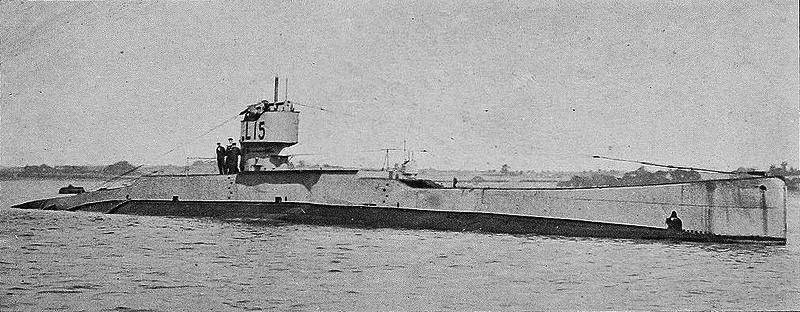
HMS L15 starboard bow view, initial state with the deck gun (not fitted) and Group I type CT. As completed on the Tyne, January 1918.
One of the first Group II boats, L 15 was completed at Fairfield Shipbuilding and Engineering Co. and commissioned on 16 January 1918. She sailed with the Depot Ship HMS Ambrose to Hong Kong in 1919 (4th SubFlot) based there in January 1920, sold 1932.
As of note, L 10 (lead boat, Group II) saw more action in WWI: Completed in June 1918, she was in the North Sea to deter German surface units trying to lay mines in British waters. On the morning of 3 October 1918, after just 4 months service she surfaced in the Heligoland Bight to intercept a raiding party (torpedo boats S34, S33, V28 and V79) assisting S34 which hit a mine. L 1 captain’s Alfred Edward Whitehouse senaked in an torpedoed S33, was fired back by V28, S33, S 60 and V79 and not fast enough to escape she was sunk at 11:03 with all hands, the only L-class lost in the First World War.
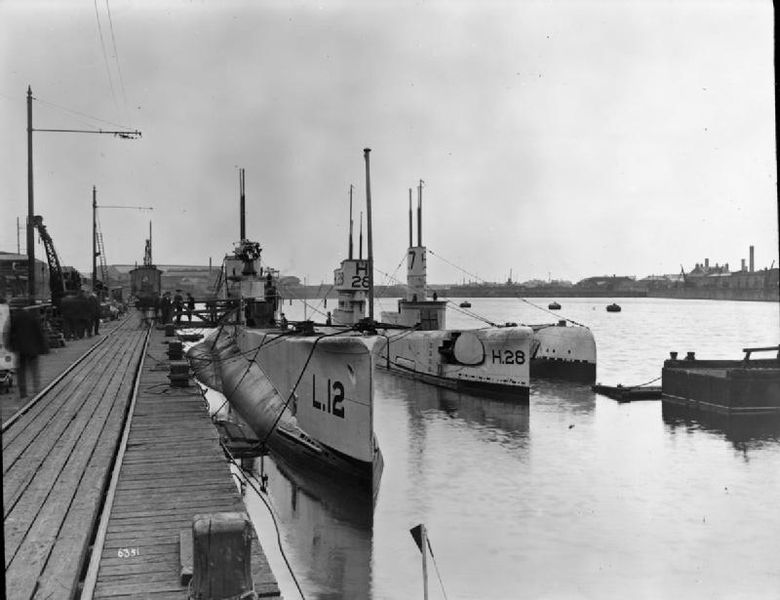
HMS L12 and H28
HMS L12 (commissioned 30 June 1918) collided with HMS H47 off Milford Haven, Wales on 9 July 1929 and was repaired at Milford Haven, however 3 sailors died. HMS L14 left her Grubb & Co periscope after being sold for BU in 1934, purchased and now on display at the Royal Navy Submarine Museum at Gosport. L 16 saw service from Harwich or Teesport (comp. May 1918).
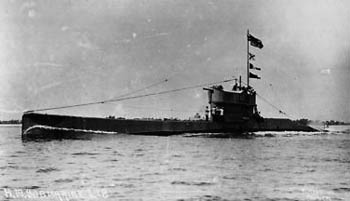 L 18 (comp. 15 May 1919) by February 1927 trained with HMS X1 and HMS L26. Sold 1936. L 19 (completed 2 August 1919) also served with the 4th Submarine Flotilla/HMS Titania at Hong Kong in the interwar, just like L 20 but not for long (arrived 1920, reserve 1923, sold 1935). These postwar boats were more of a local deterrence in case Japanese actions in the region would justify Royal Navy actions. Without crews however they lost and edge in training.
L 18 (comp. 15 May 1919) by February 1927 trained with HMS X1 and HMS L26. Sold 1936. L 19 (completed 2 August 1919) also served with the 4th Submarine Flotilla/HMS Titania at Hong Kong in the interwar, just like L 20 but not for long (arrived 1920, reserve 1923, sold 1935). These postwar boats were more of a local deterrence in case Japanese actions in the region would justify Royal Navy actions. Without crews however they lost and edge in training.
 HMS L 23 (1918)
HMS L 23 (1918)
L23 had a more interesting career as she served in WW2 as well. Indeed she was towed to Chatham Royal Dockyard and only completed on 31 October 1924. China Station in the 1920s and back home for training, then pressed in action. Fitted with the new Type 118 asdic set, and was in the 6th Submarine Flotilla at Portland in 1937, taking part in North Sea exercises based in South Harbour, Blyth. By Setember 1939 she served with the 5th Flotilla (Portsmouth) to train crews, and sailed with HMS Skate on 28 September 1939 for her first operational training under 1st Lt. Claude Peterkin, training behind the east coast convoy FN12. Hr first patorl started on 11 October 1939 to the Dogger Bank/Zone A2 (Minefield).
The German raid expected never materialise. Her second patrol was deep in the Skaggerak, Zone C2, 3rd patrol started on November 12, at ambush position of GDM, Zones A, A1 and A3 and Little Fisher Bank but missed the Scharnhorst, Gneisenau and Koln, Leipzig en route for a raid. The 5th patrol (from December 17) was to gather intel at the Skaggerak off Kristiansund, under Lt. Leslie Hill. Her 6th patrol in January 1940 was to escort an incoming convoy from Bergen.
The 6th patrol was on zone A2 and the 7th (February 12) was the same, but on February 20, at 00:55, she surfaced, only to be surprised by German destroyers Wilhelm Heidkamp and Karl Galster (escorts to Scharnhorst, Gneisenau, Admiral Hipper gathered for Operation Nordmark) at 700 yds. She dived and stayed “dead silent” after the surviving report from HMS Spearfish, and ultimately they stopped their heavy depth charge attack after detecting a real oil leak, so they believed she was destroyed. L23 stayed silent until the limit of her underwater autonomy and departed froml the area to tell the tale. She made a last patrol and after a comprehensive refit and modernization, she was posted on the West coast of Scotland notably to train Chariot crews, until sold for scrap in May 1946. Full records on the sources below.
For note, L 24 was sunk in a collision (all hands) with the battleship Resolution during an exercise off Portland Bill (Channel) on 10 January 1924, under 52 meters. L 25 ran aground off The Needles, Isle of Wight on 7 April 1924 but was refloated later.
 HMS L 26 (1919)
HMS L 26 (1919)
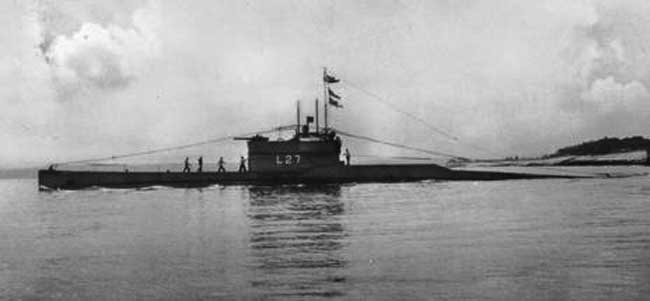
L26 was one of the rare boats also operational in WW2: Built by Vickers, Barrow, launched 29 May 1919, transferred to HM Dockyard, Portsmouth for completion on 11 October 1926. Assigned to the Mediterranean and damaged in March 1929, repaired Gibraltar. 7 October 1933 rane aground with L19 ran off Kintyre, refloated. 8 October, suffered an explosion (battery compartment) while at Campbeltown Harbour in Scotland (2 killed, 10 injured) with Lt.Cdr John Hugh Lewis Court-martialled as the batteries were damaged after the grounding. In 1939, L26 was assigned to the 6th Submarine Flotilla. 26–29 August saw her deployed at Dundee and Blyth and by 20 September-15 January 1940 she made severa patrols, deployed off Skagerrak, Jutland and Horns Reef. From 22 March 1941, she was deployed off Brest to ambush the battleships Gneisenau and Scharnhorst. Transferred to Canada in 1943 as ASW training ship in Digby, Nova Scotia (HMCS Cornwallis) and in Bermuda (HMCS Somers Isles). Purchased 1946, sunk as a target for sonar testing 25 September.
L 27 (photo) had a very similar career and postings from 1939. On 15 October 1940 she attacked a German convoy unsuccessfully in the English Channel. Brest patrol. After refit she was a training boat at Portsmouth, BU in Canada, 1944.

L 33, on 16 March 1926, collided with another unknown vessel but with light damage. In 1928, assigned to the China Station with L15, L19, and L27. Sold for scrapping February 1932. Intermediate series (L28-32 and 36-49 50,51, 57-68) were all cancelled.
 HMS L 52 (1918)
HMS L 52 (1918)
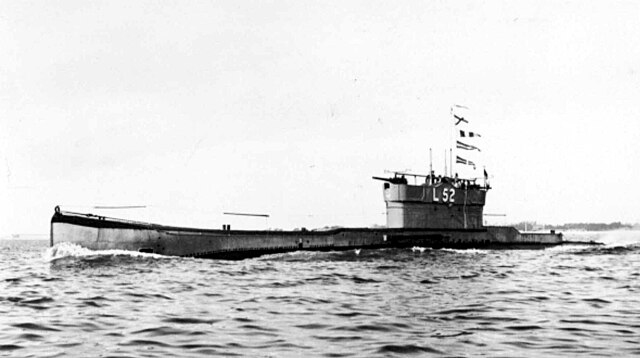
Completed on 18 January 1921, she served from June 1923 only with full complement. She collided wit L 1 leading to a Court of Enquiry which on 23 November, 1923, blamed Lt. Cdr. Frank D. Morris.
1925: 2nd Submarine Flotilla, Mediterranean.
Full commission 4 March, 1927, mid-1927 5th Submarine Flotilla, 1929, 2nd Submarine Flotilla. Mid-1931, transferred 5th Submarine Flotilla. 1933, deactivated, Portsmouth reserve from 15 May 1934. Sold for scrap in September 1935, wrecked off Barry, South Wales.
L 53 was completed 16 January 1925, sold for scrap on 23 January 1939. L 54 completed 27 August 1924, sold for scrap 2 February 1939. L 56 was completed on 3 September 1919, sold for scrap on 25 March 1938.
 HMS L 55 (1918)
HMS L 55 (1918)
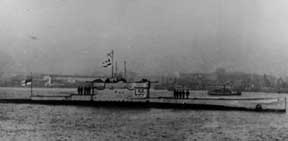 L 55 had a more interesting story: Commissioned on 19 December 1918 she based at Tallinn, Estonia, for the Baltic Battle Squadron supporting the Baltic states fighting for independence and the Bolsheviks. On 9 June 1919 she was in Caporsky Bay, Gulf of Finland when attacking two Bolshevik Orfey-class minelayers, Gavriil and Azard. She missed and to escape, ended in a British-laid minefield although Soviet sources claimed she was sank by gunfire. Anyway, she wreck was found again in 1927, she was raised on 11 August 1928, remains of the crew returned on the British merchantman Truro and she was studied and rebuilt by Baltic Works in Leningrad (1 million rouble through public fund as “an answer to Chamberlain”). Recommissioned as a Л-55 Bezbozhnik on 7 August 1931. Inspired the Soviet L-class submarines and used for training until she was damaged in early 1941, scrapped 1953 or even 1960. Certainly at that stage the very first L class in existence anywhere…
L 55 had a more interesting story: Commissioned on 19 December 1918 she based at Tallinn, Estonia, for the Baltic Battle Squadron supporting the Baltic states fighting for independence and the Bolsheviks. On 9 June 1919 she was in Caporsky Bay, Gulf of Finland when attacking two Bolshevik Orfey-class minelayers, Gavriil and Azard. She missed and to escape, ended in a British-laid minefield although Soviet sources claimed she was sank by gunfire. Anyway, she wreck was found again in 1927, she was raised on 11 August 1928, remains of the crew returned on the British merchantman Truro and she was studied and rebuilt by Baltic Works in Leningrad (1 million rouble through public fund as “an answer to Chamberlain”). Recommissioned as a Л-55 Bezbozhnik on 7 August 1931. Inspired the Soviet L-class submarines and used for training until she was damaged in early 1941, scrapped 1953 or even 1960. Certainly at that stage the very first L class in existence anywhere…
L 69 was launched on 6 December 1918, towed to Rosyth for completion, 18 April 1923. Sold to Arnott Young, February 1939 for scrap.
L 71 was completed on 23 January 1920, joined the 2nd Submarine Flotilla at Devonport. Sold for scrap 25 March 1938, Milford Haven.
Read More
Books
Conway’s All the World’s Fighting Ships 1921-47
Akermann, Paul (2002). Encyclopaedia of British Submarines 1901–1955 (reprint of the 1989 ed.). Penzance, Cornwall: Periscope Publishing
Bagnasco, Erminio (1977). Submarines of World War Two. Annapolis, Maryland: Naval Institute Press.
Caruana, Joseph (2012). “Emergency Victualling of Malta During WWII”. Warship International.
Colledge, J. J.; Warlow, Ben (2006) [1969]. Ships of the Royal Navy: The Complete Record of all Fighting Ships of the Royal Navy (Rev. ed.). Chatham Publishing.
McCartney, Innes (2006). British Submarines 1939–1945. New Vanguard. Vol. 129. Oxford, UK: Osprey.
Hutchinson, Robert (2001). Jane’s Submarines: War Beneath the Waves from 1776 to the Present Day. London: HarperCollins.
Colledge, J. J.; Warlow, Ben (2006) [1969]. Ships of the Royal Navy: Complete Record, Chatham Publishing.
Links
http://www.dreadnoughtproject.org/tfs/index.php/%22L%22_Class_Submarine_%281917%29
https://www.rnsubmusfriends.org.uk/hezlet/appenix/Particulars%20of%20British%20Submarines%201939/L-Class.htm
http://rnsubs.co.uk/boats/subs/l-class.html
https://www.worldnavalships.com/l_class.htm
https://www.battleships-cruisers.co.uk/l_class.htm
https://britsub.x10.mx/html/boats/l_class/l_class.html
https://britsub.x10.mx/html/boats/l_class/l_class2.html
https://britsub.x10.mx/html/boats/l_class/l_class3.html
https://en.wikipedia.org/wiki/British_L-class_submarine
https://ru.wikipedia.org/wiki/HMS_L55
https://commons.wikimedia.org/wiki/Category:British_L_class_submarines



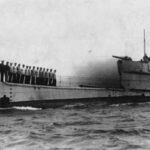
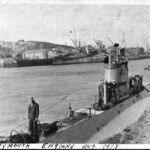
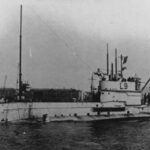
 Latest Facebook Entry -
Latest Facebook Entry -  X(Tweeter) Naval Encyclopedia's deck archive
X(Tweeter) Naval Encyclopedia's deck archive Instagram (@navalencyc)
Instagram (@navalencyc)





 French Navy
French Navy Royal Navy
Royal Navy Russian Navy
Russian Navy Armada Espanola
Armada Espanola Austrian Navy
Austrian Navy K.u.K. Kriegsmarine
K.u.K. Kriegsmarine Dansk Marine
Dansk Marine Nautiko Hellenon
Nautiko Hellenon Koninklije Marine 1870
Koninklije Marine 1870 Marinha do Brasil
Marinha do Brasil Osmanlı Donanması
Osmanlı Donanması Marina Do Peru
Marina Do Peru Marinha do Portugal
Marinha do Portugal Regia Marina 1870
Regia Marina 1870 Nihhon Kaigun 1870
Nihhon Kaigun 1870 Preußische Marine 1870
Preußische Marine 1870 Russkiy Flot 1870
Russkiy Flot 1870 Svenska marinen
Svenska marinen Søværnet
Søværnet Union Navy
Union Navy Confederate Navy
Confederate Navy Armada de Argentina
Armada de Argentina Imperial Chinese Navy
Imperial Chinese Navy Marinha do Portugal
Marinha do Portugal Mexico
Mexico Kaiserliche Marine
Kaiserliche Marine 1898 US Navy
1898 US Navy Sovietskiy Flot
Sovietskiy Flot Royal Canadian Navy
Royal Canadian Navy Royal Australian Navy
Royal Australian Navy RNZN Fleet
RNZN Fleet Chinese Navy 1937
Chinese Navy 1937 Kriegsmarine
Kriegsmarine Chilean Navy
Chilean Navy Danish Navy
Danish Navy Finnish Navy
Finnish Navy Hellenic Navy
Hellenic Navy Polish Navy
Polish Navy Romanian Navy
Romanian Navy Turkish Navy
Turkish Navy Royal Yugoslav Navy
Royal Yugoslav Navy Royal Thai Navy
Royal Thai Navy Minor Navies
Minor Navies Albania
Albania Austria
Austria Belgium
Belgium Columbia
Columbia Costa Rica
Costa Rica Cuba
Cuba Czechoslovakia
Czechoslovakia Dominican Republic
Dominican Republic Haiti
Haiti Hungary
Hungary Honduras
Honduras Estonia
Estonia Iceland
Iceland Eire
Eire Equador
Equador Iran
Iran Iraq
Iraq Latvia
Latvia Liberia
Liberia Lithuania
Lithuania Mandchukuo
Mandchukuo Morocco
Morocco Nicaragua
Nicaragua Persia
Persia San Salvador
San Salvador Sarawak
Sarawak Uruguay
Uruguay Venezuela
Venezuela Zanzibar
Zanzibar Warsaw Pact Navies
Warsaw Pact Navies Bulgaria
Bulgaria Hungary
Hungary

 Bundesmarine
Bundesmarine Dutch Navy
Dutch Navy Hellenic Navy
Hellenic Navy Marina Militare
Marina Militare Yugoslav Navy
Yugoslav Navy Chinese Navy
Chinese Navy Indian Navy
Indian Navy Indonesian Navy
Indonesian Navy JMSDF
JMSDF North Korean Navy
North Korean Navy Pakistani Navy
Pakistani Navy Philippines Navy
Philippines Navy ROKN
ROKN Rep. of Singapore Navy
Rep. of Singapore Navy Taiwanese Navy
Taiwanese Navy IDF Navy
IDF Navy Saudi Navy
Saudi Navy Royal New Zealand Navy
Royal New Zealand Navy Egyptian Navy
Egyptian Navy South African Navy
South African Navy






























 Ukrainian Navy
Ukrainian Navy dbodesign
dbodesign